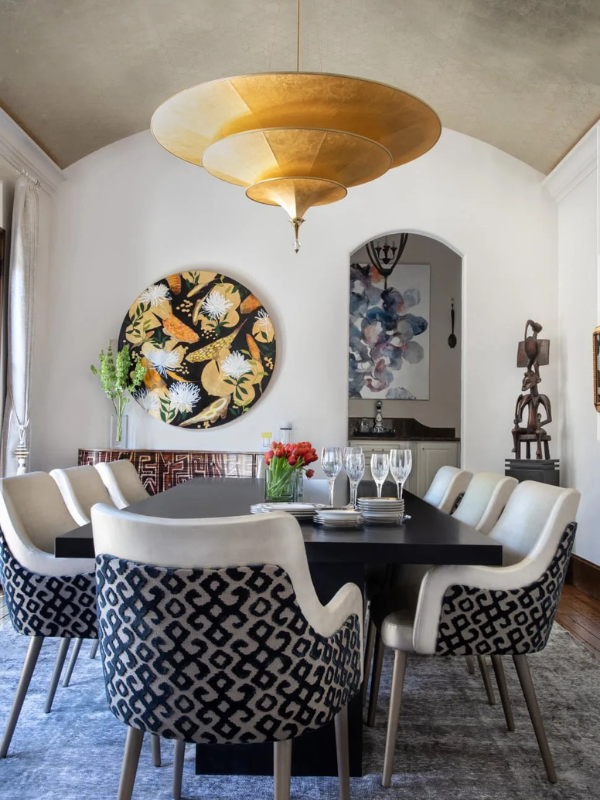Though often neglected, the “fifth wall” (ceiling) has just as much design potential as the walls and floor. And when treated with wallpaper, it can complete the entire interior. Sometimes, ceiling wallpaper nurtures intimacy in a large living area that might otherwise feel far too cavernous; sometimes, it adds drama to a tiny powder room; and sometimes, it makes a dining room feel elegant and unexpected.
At Laura U Design Collective, we never approach ceiling wallpaper as a gimmick. We use it the way we’d use art, millwork, or custom textiles: thoughtfully and always in dialogue with the architecture. In projects like West U Contemporary, Circle Drive, and Highland Village Contemporary, wallpaper on the ceiling is defining. It supports the palette, enhances the architecture, and adds an elevated element of surprise.
How Interior Designers Use Ceiling Wallpaper to Complete Spaces
They Use Wallpaper to Alter Perception of Scale
Every room has a ceiling, but not every ceiling is put to work in its interior. Interior designers often call it the “fifth wall” for good reason; what happens overhead can redefine the scale of a space. In a tall dining room, ceiling wallpaper can establish intimacy. In a wide library or study, a repeating pattern overhead creates rhythm. Without it, the architecture risks feeling untethered.
Why Scale Matters
In rooms with soaring ceilings, proportions can feel off-balance. Ceiling wallpaper helps correct that scale by drawing the eye upward with intention. A grasscloth or tonal pattern can soften the expanse; a geometric repeat can organize it; and a metallic or lacquered finish (like the dining room at Highland Village Contemporary) can bounce light in ways that make the room feel spacious all the way around (not just upward).
When Paint Acts Like Paper
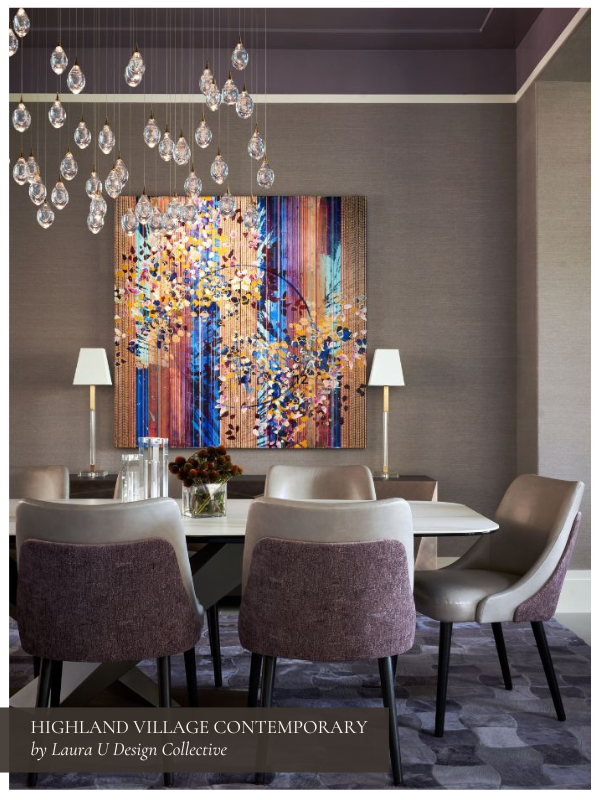
Not every ceiling needs traditional wallpaper. At Highland Village Contemporary, for instance, we lacquered the dining room ceiling in a moody gray-violet. The surface reflects light much the way metallic wallpaper does, but in this case, it looks almost like a pool of water. During the day, natural light ripples across the finish. At night, a cascade of glass pendants multiplies overhead to make the room feel dramatic, almost cinematic.

They Use Wallpaper to Extend the Palette Upward
Most interiors stop at the crown molding, leaving ceilings white and often detached from the design if they lack architectural elements like arches or wooden beams. But when ceiling wallpaper extends the palette upward, the fifth wall can be a natural part of the composition instead of an afterthought.
Why Continuity Matters
In a bedroom, a pale gray grasscloth on the ceiling can reinforce the calmness a primary suite should invoke without introducing another color and risk muddying the palette. In a dining room, carrying deep blue overhead adds richness and connects the walls and ceiling into one envelope; we especially love a selection like this in wine rooms or dens. It almost feels like a true wine cave! Even a subtle strié in white or cream shifts the surface from plain drywall to a considered design choice.
Quiet or Bold
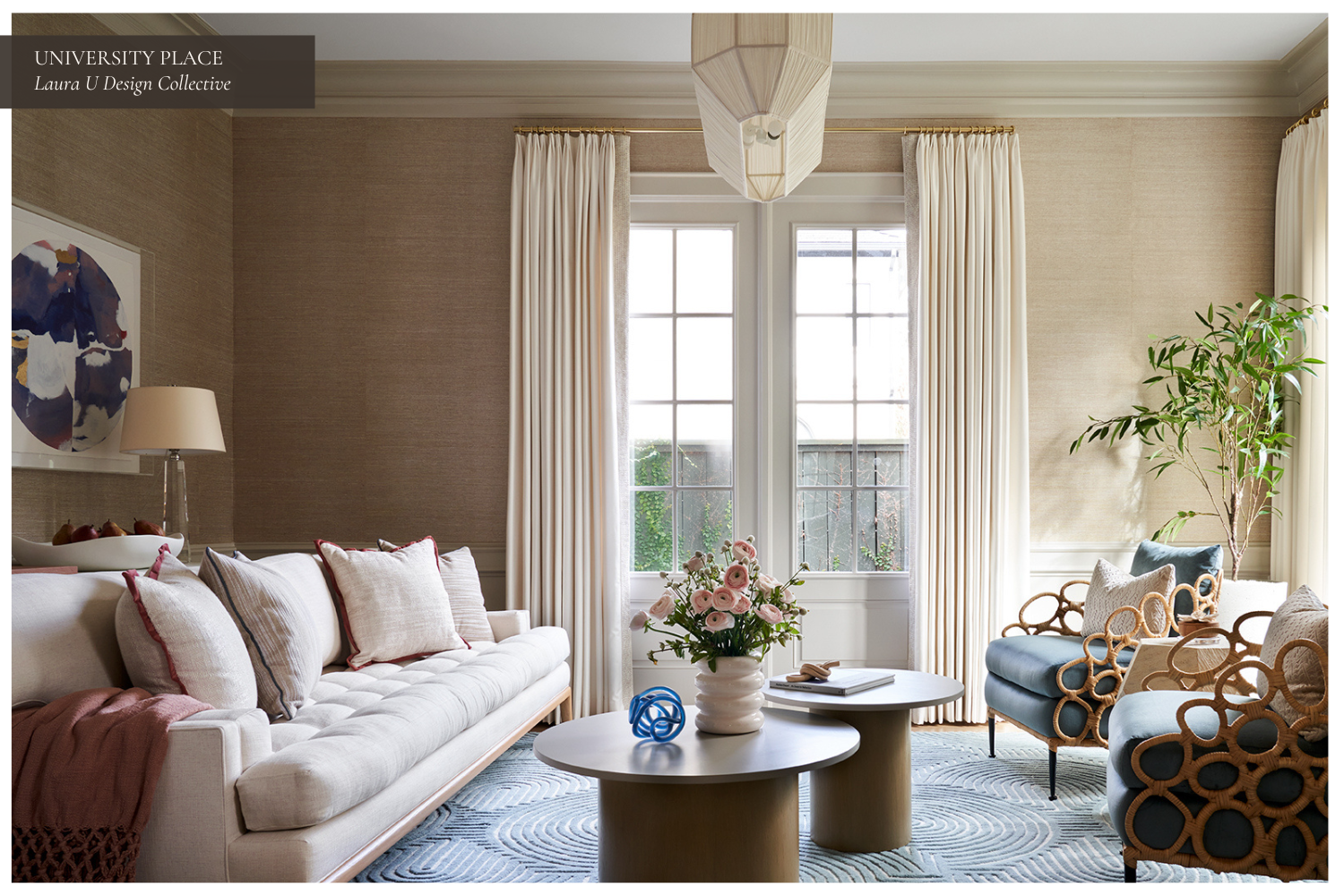
The effect doesn’t need to be dramatic. Some ceilings work best with understated texture that supports the existing palette. Extending color and texture overhead helps a space read as finished. Instead of the eye stopping at the wall, it continues upward, and the room feels elevated, cohesive, and complete.
If you prefer not to install wallpaper as part of the interior design of your space, consider painting the molding in a similar color to the room’s wallcovering. We did just that in the formal living room of our University Place project; while it doesn’t extend fully into the ceiling, that added touch makes the space feel so much more cohesive. We hope you use this space as inspiration!
They Use Ceiling Wallpaper to Add Texture
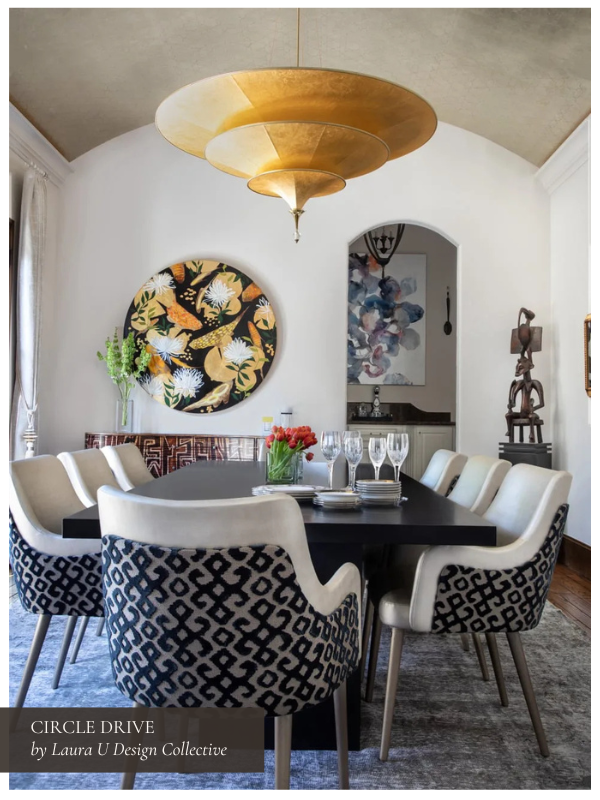
Wallpaper on the ceiling needn’t always bring bold pattern or saturated color. Some of the most successful treatments lean on texture instead. Grasscloth, metallic leaf, and embossed papers all add quiet detail overhead, helping the ceiling feel finished without competing with the architecture.
Why Texture Matters
Texture overhead changes how a room functions as much as how it looks. Grasscloth absorbs sound and softens the atmosphere, echoing the fabric textures below. Metallic finishes reflect light differently throughout the day, brightening a room in the afternoon and giving it a glow by lamplight at night. Embossed papers add depth through shadow, which is a subtle way to make the ceiling read as more considered and complete than paint alone.
How Designers Apply It
In living areas, a pale grasscloth ceiling can warm an otherwise cool, neutral palette and tie into natural textures in the furniture. Jewel-toned grasscloths in dining rooms add drama while keeping the envelope cohesive.
Metallic and embossed options widen the range. Silver leaf makes a powder room feel luminous, while bronze or copper add weight to a study lined in dark wood. Embossed papers, with their raised motifs, work especially well in historic or transitional homes as they often echo the character of millwork and plaster.
Project Highlight: Circle Drive Dining Room
In the dining room at Circle Drive, ceiling wallpaper makes the space feel more glamorous. A pale gold finish reflects the koi painting by Joseph Bradley and multiplies the sparkle of the chandelier. Rather than competing with the artwork, the ceiling reinforces the palette: ivory curtains, blue upholstery, and golden undertones all find an echo above.
They Balance Surprise with Subtlety and Situational Appropriateness
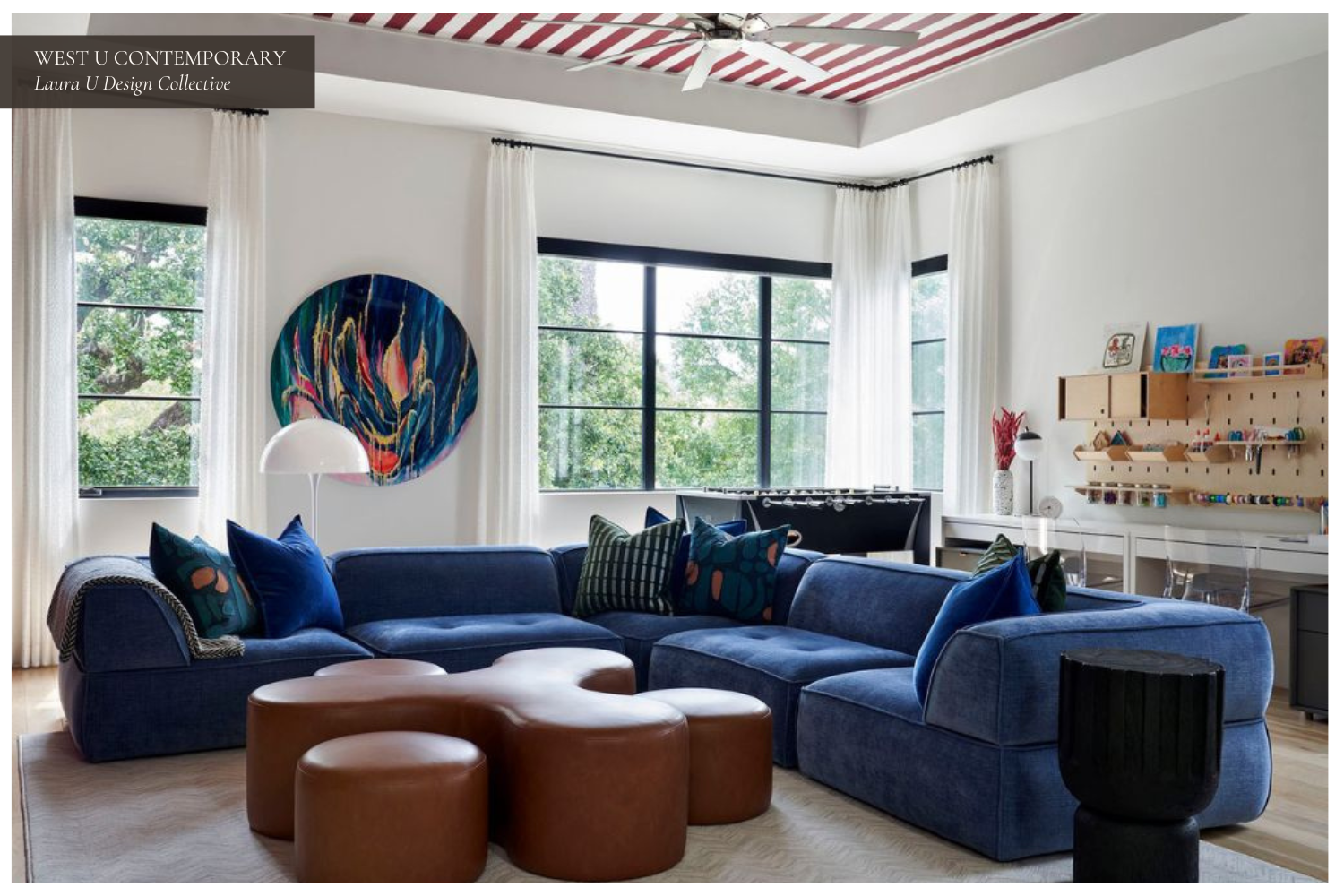
Ceiling wallpaper should feel a bit more discovered than declared. It works best when it feels like a natural extension of the room rather than a solo statement piece that doesn’t quite tie to other elements.
The most successful treatments are either noticed gradually (i.e., a metallic leaf that catches light at dusk) or pack a punch but do so in a way that elaborates on the existing interior design scheme. Whether peel and stick or expertly pasted to your ceiling, perfectly applied wallpaper doesn’t announce itself all at once, but the space feels more complete because of it.
Avoiding the “Theme-Park” Ceiling
The danger here lies in treating your ceiling as a blank canvas for unnecessary spectacle through crazy styles that do nothing for the room. Note how overly literal motifs or high-contrast prints from a bold wallpaper collection that would perform better in small spaces can veer into “theme-park” territory. The home shouldn’t feel like a set; this isn’t the theater. A cloud-filled, daydream wallpaper in a child’s bedroom may be entirely charming and fun, but in most interiors, restraint has greater impact. More on this a bit later.
Materials That Surprise Quietly
Designers achieve balance by letting materials do most of the work. Grasscloth, metallic leaf, or striés can all subtly surprise guests without stealing focus. A bronze finish in a more traditional study, for instance, feels dramatic but still aligns with the weight of wood paneling and leather upholstery. In a dining room, a midnight-blue paper overhead may feel bold, yet it makes sense against the richness of the furnishings.
Why Longevity Matters
Clients live with ceilings every day. A surface that dazzles in the moment but feels dated within a year is never a good investment. That’s why we return to wallpapers that either echo timeless natural materials or truly reflect the client’s personality and heritage.
Project Highlight: West U Contemporary Game Room
In the game room at West U Contemporary, striped ceiling wallpaper from Schumacher extends the palette upward by pulling burgundy from the dining room below. The pattern feels playful enough for a craft and gaming space, yet it remains grounded in the jewel tones of the artwork and custom upholstery. For a young family, this balance was essential: bold enough to reflect the children’s personalities, but tailored enough to grow with them.
They Respect the Architecture When Selecting Ceiling Wallpaper or Finishes
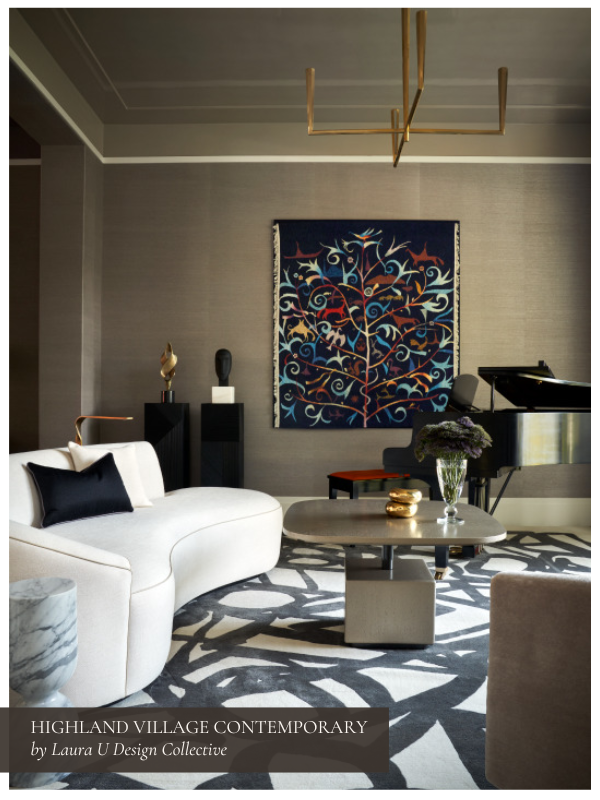
Wallpaper on a ceiling should never feel like an afterthought. It should read as part of the architecture itself, not something pasted on top. The difference between success and distraction usually comes down to how well the treatment works with the bones of the room.
When It Makes Sense
Certain ceiling types welcome wallpaper. Coffered and tray ceilings, for instance, create natural boundaries that frame a material beautifully. A grasscloth lining inside a coffer can feel like an extension of the millwork; it’s almost always stunning. Even in rooms with strong vertical lines (i.e., a dining room with tall wainscoting), carrying a color or texture overhead can make the space feel fully considered.
When Restraint Is Better
Not every ceiling needs attention. In low-ceilinged halls or irregularly shaped rooms, wallpaper overhead can feel heavy or forced. Here, paint in a complementary tone often is far more graceful but still impactful. Our goal is always balance: letting architecture lead and empowering wallpaper to support rather than compete.
Remember, ceiling wallpaper succeeds when it looks inevitable; it’s as if it were designed with the house, not added years later. That’s why restraint matters just as much as (if not more than) being bold.
Project Highlight: Highland Village Contemporary Receiving Room
In this Highland Village receiving room, the lacquered ceiling treatment was kept deliberately quiet to let the architecture speak. The layered trim and crisp planes define the volume of the space, while the surface finish subtly echoes the walls. By choosing restraint, the ceiling feels integrated rather than separate. It repeats the space’s existing geometry instead of competing with it.
That discipline allows the bolder design selections below to confidently accept their starring roles: the sculptural Demuro Dos sofa, the graphic Holly Hunt rug, and the richly textured Phillip Jeffries wallcovering. Together, the interplay of architecture and decoration creates a space that feels tailored, intentional, and enduring.
Bringing It All Together with Laura U Design Collective
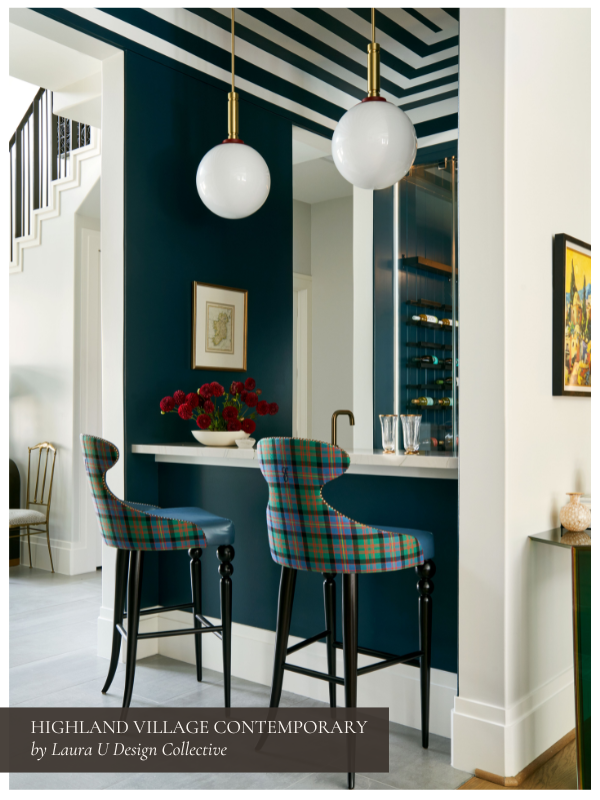
Adding ceiling wallpaper or lacquered paint helps interior designers achieve balance, intention, and architectural cohesion. At Laura U Design Collective, we approach every “fifth wall” with the same care we bring to millwork, textiles, art, and all your other walls!
Our goal is always the same: to create interiors that feel cohesive, elevated, and deeply personal. If you’re ready to explore how a considered ceiling treatment can transform your home, we’d love to collaborate with you.



